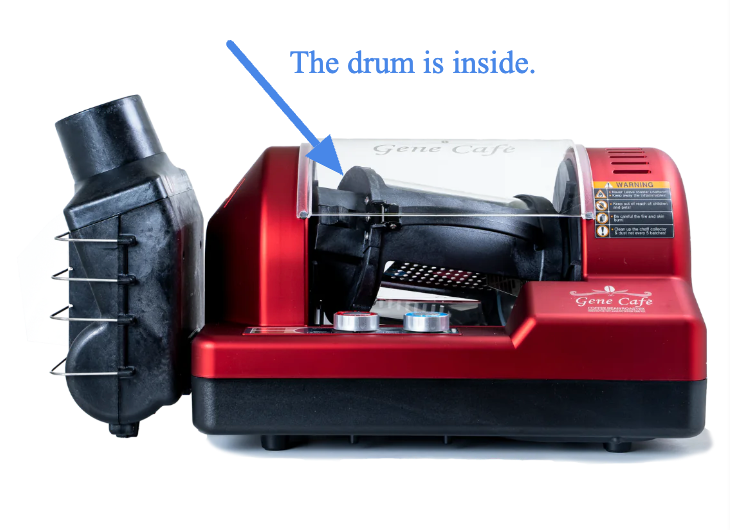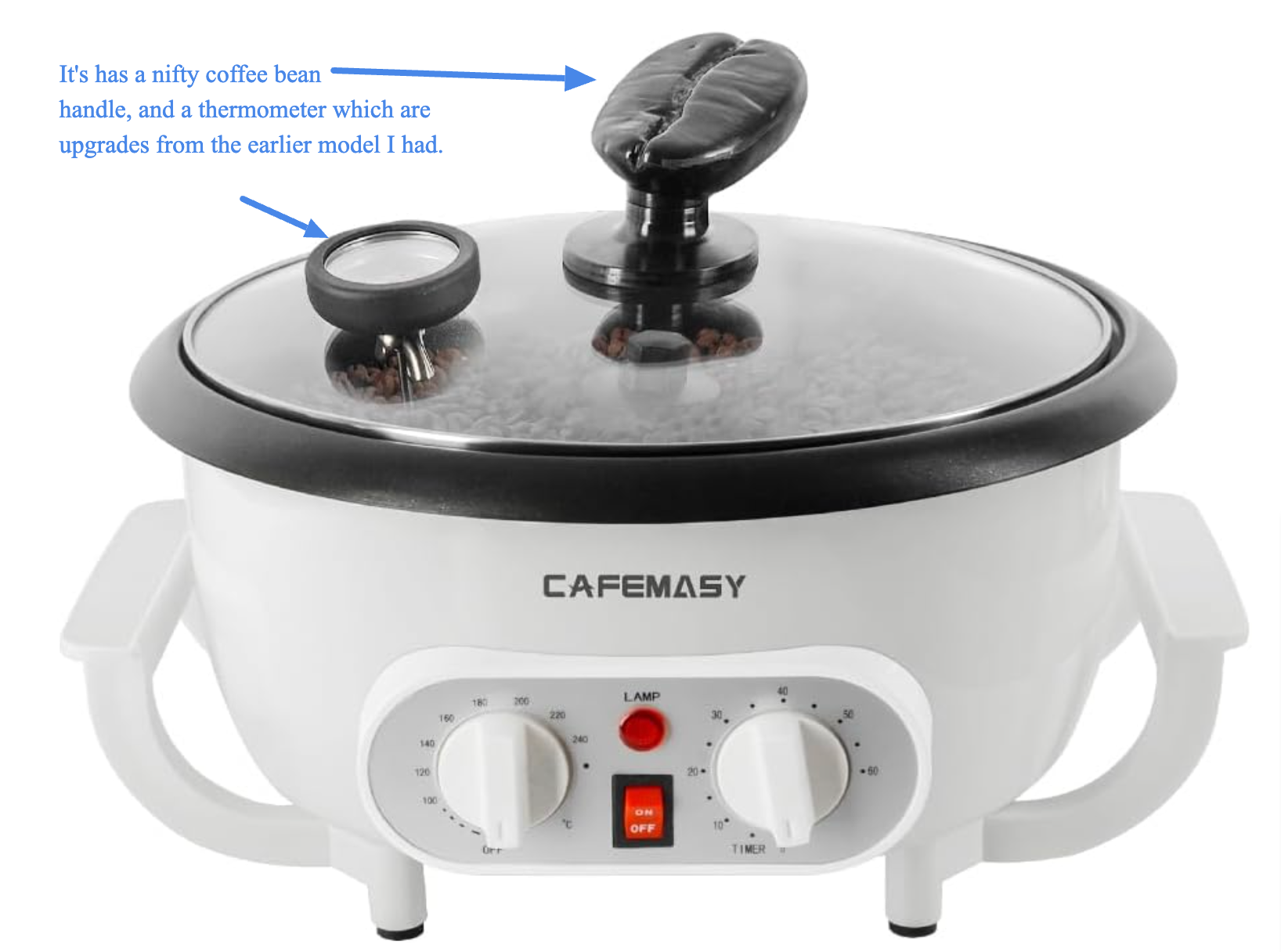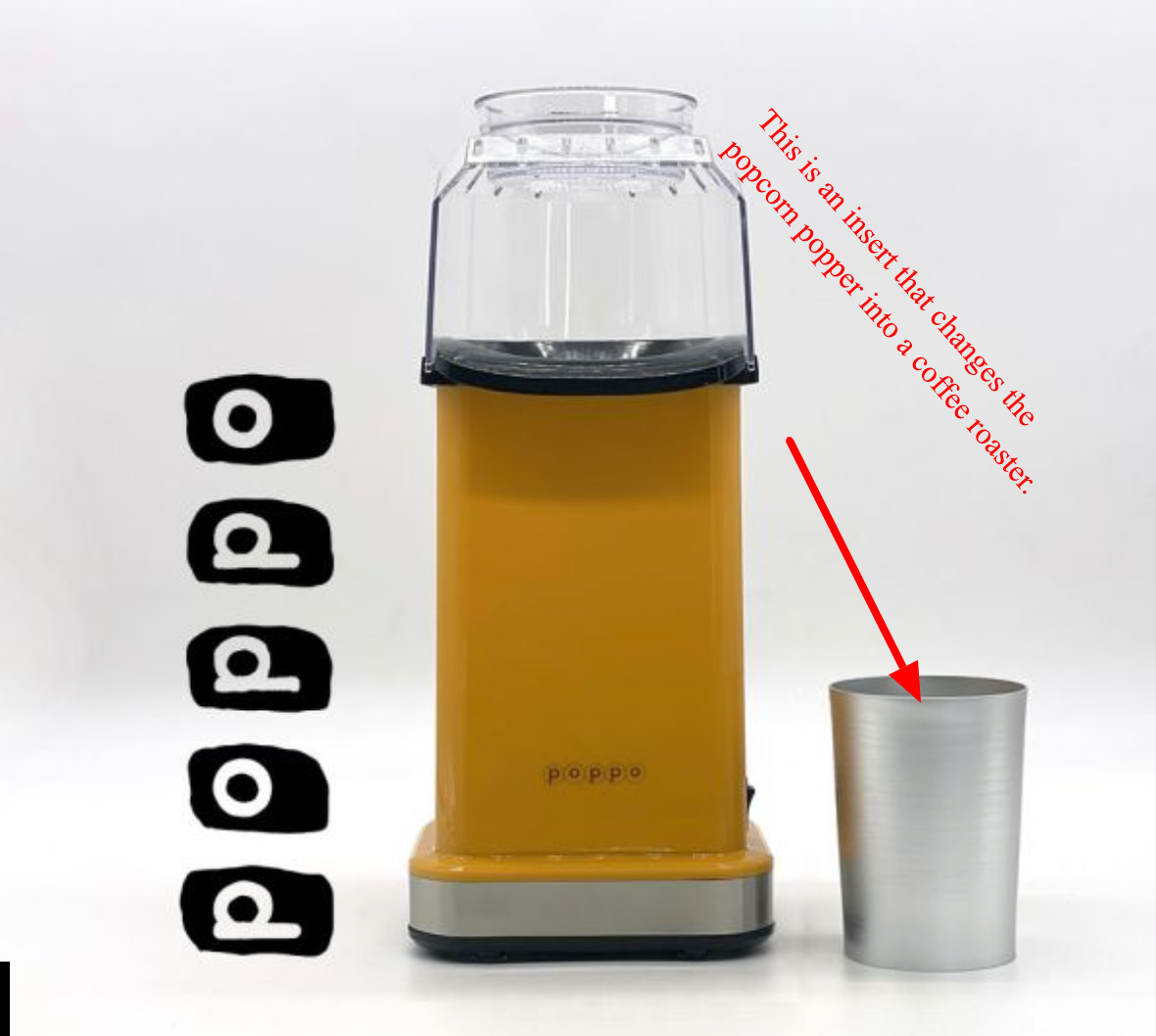So, you've decided to dabble in roasting your own coffee beans. You want to taste what it’s like to have complete control over your coffee's flavor profile: maybe you want to capture that perfect chocolatey cup, or maybe you’re looking to get a nutty or fruity flavor at home and not a coffee shop. Perhaps, you’re sick of stale coffee that you get in the store or you want really good fresh coffee that doesn’t cost the same as a cocktail.
But with so many options available, choosing your first coffee roaster can feel overwhelming. This guide will help you navigate the different types of roasters and make an informed decision that fits your needs and budget.
Understanding Different Types of Home Coffee Roasters
Let's explore each type of coffee roaster, from simple solutions to more advanced options, helping you understand which might be right for you.
1. Air Roasters

Air roasters use hot air to both heat and move the beans, similar to how a popcorn popper works but designed specifically for coffee. (And if you’re wondering about using popcorn poppers, details on that are at the end.)
How They Work:
- Hot air circulates and heats the beans
- Beans "float" and move in the hot air stream
- Temperature controlled electronically
- Usually include built-in cooling cycles
Popular Models and Price Ranges:
- Fresh Roast SR540 ($200-250): Excellent starter model
- Fresh Roast SR800 ($300-350): Larger capacity version (This is what I use.)
- Aillio Bullet ($2500+): Professional-grade air roaster
Advantages:
- Fast roasting times (8-12 minutes)
- Very consistent results
- Easier learning curve
- Clean process with good chaff collection
- Usually include cooling cycles
Disadvantages:
- Smaller batch sizes (2-4 oz typical)
- Can be noisy during operation
- Limited control over roast profile
- May not be as durable as other types
2. Drum Roasters

Drum roasters are the professional standard, scaled down for home use. They offer the most control but come with a steeper learning curve.
How They Work:
- Rotating drum provides even heat distribution
- Heating element or gas flame provides heat
- Beans tumble continuously in the drum
- Temperature controlled electronically
- Often include sophisticated profiling options
Popular Models and Price Ranges:
- KALDI Wide ($450-550):
- Behmor 2000AB Plus ($500-600): Popular home model
- Gene Cafe ($600-700): Semi-professional option
- Hottop ($1000+): Professional-grade features
Advantages:
- Larger batch sizes (8-16 oz)
- Excellent control over roast profile
- Most durable construction
- Professional-style results
- Great for serious enthusiasts
Disadvantages:
- Higher initial investment
- Steeper learning curve
- Longer roast times
- More complex cleaning required
- Larger space requirements
3. Mixing Rod/Stirring Roasters
I started with a mixing rod roaster. For beginners, they offer an excellent entry point into home roasting. They use an electric pan combined with a mechanical stirring rod to ensure even roasting.

How They Work:
- An electric heating element provides consistent heat
- A mechanical rod continuously stirs the beans
- Beans are visible through a glass cover
- Temperature is controlled either manually or electronically
- Chaff collection systems vary by model
Popular Models and Price Ranges:
- Nuvo Eco ($30+): Budget-friendly option
- Jiawanshun ($100): Simple but effective design
Advantages:
- Excellent bean visibility during roasting
- Good batch sizes (typically 8-12 oz)
- More control than air roasters
- Generally more affordable than drum roasters
- Easier to learn than drum roasters
- Simple maintenance
Disadvantages:
- Some models lack sophisticated temperature control
- Stirring rods may wear out over time
- Manual temperature adjustment in basic models
- May require more attention during roasting
- Difficult to clean
Alternative Methods: The Popcorn Popper Approach
Before dropping the cash for a real coffee roaster, many people start with a simple popcorn popper. I have never used one, but it may be a good way to start if you’re on a tight budget.
How Popcorn Poppers Work for Coffee Roasting:
- Hot air circulation system similar to other air roasters
- Temperature ranges typically between 350-500°F
- Agitation through air movement
- Usually roasts 2-3 oz per batch
Recommended Models:
- Poppo (an affordable popcorn popper modified for roasting coffee)

- West Bend Poppery
- Pop Lite by Presto Note: Look for models with side vents rather than mesh-bottom designs
Advantages of Popcorn Poppers:
- Very affordable ($20-40)
- Readily available
- Simple to operate
- Good visibility of the roasting process
- Easy to learn basic roasting principles
- Minimal initial investment to try the hobby
Limitations and Considerations:
- Not designed specifically for coffee roasting
- Limited batch size
- No built-in temperature control
- Shorter lifespan when used for coffee
- May void manufacturer warranty
- Requires close attention during roasting
- Not ideal for darker roasts
- No cooling cycle
Safety Considerations:
- Always roast in a well-ventilated area
- Never leave the popper unattended
- Keep a fire extinguisher nearby
- Use outdoors or under a strong vent hood
- Allow proper cool-down time between batches
- Monitor for any electrical issues
- Replace the popper if you notice any problems
Getting Started with a Popcorn Popper:
Essential Equipment:
- Popcorn popper
- Large bowl for cooling
- Heat-resistant gloves
- Long-handled wooden spoon
- Timer
- Thermometer (optional)
- Scale for measuring beans
Process Overview:
- Measure 2-3 oz of green beans
- Preheat popper for 30 seconds
- Add beans and start timer
- Watch for color changes
- Listen for first and second crack
- Dump beans into cooling bowl at desired roast level
- Cool quickly. (Pouring the beans between two bowls from a height a foot outside allows you to cool and allow the chaff to blow off.)
- Allow 20-30 minutes between batches
Tips for Success:
- Start with smaller batches (2 oz) until you learn the process
- Keep detailed notes of times and temperatures
- Use lighter roast profiles initially
- Clean the popper thoroughly after each use
- Monitor the power cord for any heat damage
Cost Analysis:
Initial Investment:
- Popcorn popper: $20-40
- Basic accessories: $20-30 Total: $40-70
Compared to Entry-Level Roasters:
- Air roasters: $200-500
- Mixing rod roasters: $150-600
- Drum roasters: $500+
When to Upgrade: Consider upgrading from a popcorn popper when you:
- want larger batch sizes
- want more control over the roast
- are ready for darker roasts
- are roasting multiple batches
- want more consistent results
- are ready to invest in the hobby
Key Factors to Consider When Choosing
1. How much you want to spend
Your budget will significantly influence your options, but remember to consider:
Initial Investment:
- Entry-level: $150-300 (Basic mixing rod or air roasters)
- Mid-range: $300-800 (Better mixing rod or entry drum roasters)
- High-end: $800+ (Professional-grade equipment)
Hidden Costs:
- Green coffee beans ($5-15/lb)
- Additional accessories that may be needed (like thermometers, cooling trays)
- Maintenance supplies
- Potential replacement parts
2. Batch Size Needs
Calculate your weekly coffee consumption:
- Daily coffee consumption × 7 days = Weekly needs
- Add 20% for guests and mistakes
- Consider bean storage limitations
- Factor in roasting frequency preference
For example:
- If you drink 2 cups daily (28g coffee)
- Weekly consumption: 196g (7oz)
- Recommended batch size: At least 4oz capacity
3. Space and Ventilation Requirements
Consider your roasting environment:
- Indoor vs. outdoor roasting capabilities
- Ventilation needs (all roasters produce smoke)
- Storage space for roaster and supplies
- Electrical outlet requirements
- Noise tolerance in your space
Recommendations Based on User Profiles
1. The Casual Beginner
Budget: Under $300 Best Options:
- Fresh Roast SR540
- Jiawanshun Mixing Rod Roaster
- Nuvo Eco Manual Roaster
What to expect:
- Smaller batch sizes
- More hands-on roasting experience
- Basic temperature controls
- Good learning platform
2. The Serious Enthusiast
Budget: $300-800 Best Options:
- KALDI Wide
- Fresh Roast SR800
- Behmor 2000AB Plus
What to expect:
- Larger batch sizes
- Better temperature control
- More consistent results
- Room to grow your skills
3. The Future Pro
Budget: $800+ Best Options:
- Hottop
- Gene Cafe
- Aillio Bullet
What to expect:
- Professional features
- Advanced control systems
- Larger capacities
- Durability for heavy use
Making Your Final Decision:
It really comes down to what kind of learning that you want to do. If you’re going to just dabble a little bit and don’t intend to replace all the coffee beans you use with your own roast, a popcorn popper like Poppo makes a lot of sense. If you really want to control the taste, then air roasters and drum roasters are where you want to start.
Getting Started After Purchase
Initial Setup:
- Read manual thoroughly
- Watch manufacturer videos
- Seriously. The manufacturers are often smaller companies of fellow coffee nerds who really care about roasting well with their machine.
- Keep detailed roasting logs
- Join online communities [examples]
- Start with simple profiles
First Roasts:
- Start with forgiving beans
- Roast small batches
- Focus on consistency
- Take detailed notes
- Learn to identify roast stages
Resources for Learning:
- Coffee: From Bean to Barista by Robert W. Thurston
- How to Taste Coffee: Develop Your Sensory Skills and Get the Most Out of Every Cup by Jessica Easto
- Coffee Roaster's Handbook: A How-To Guide for Home and Professional Roasters, by Len Brault
FAQs
Q: How long does it take to learn coffee roasting? A: Basic competency: 1-2 months. Mastery: Several months to years.
Q: How much can I save by roasting at home? A: Typically $5-10 per pound after equipment costs are recovered.
Q: How long do green coffee beans last? A: 6-12 months when properly stored.
Q: What's the most important feature in a first roaster? A: Consistency and ease of use are more important than advanced features.
Conclusion
Any of the roasters mentioned above can produce excellent coffee with practice. The key is to choose one that fits your lifestyle and commitment level, then focus on learning the craft of roasting. It is a lot of practice and some trial and error along the way with the reward of crafting your perfect cup of coffee.
How to Choose Your First Coffee Roaster: A Beginner's Guide
This guide will help you navigate the different types of roasters and make an informed decision that fits your needs and budget.